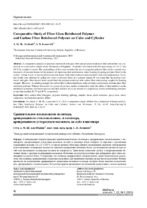| dc.contributor.author | AL-obaidi, A. M. Sh. | |
| dc.contributor.author | Leonovich, S. N. | |
| dc.coverage.spatial | Минск | ru |
| dc.date.accessioned | 2023-02-08T11:01:24Z | |
| dc.date.available | 2023-02-08T11:01:24Z | |
| dc.date.issued | 2023 | |
| dc.identifier.citation | AL-obaidi, A. M. Sh. Comparative Study of Fiber Glass Reinforced Polymer and Carbon Fiber Reinforced Polymer on Cube and Cylinder = Сравнительное исследование полимера, армированного стекловолокном, и полимера, армированного углеродным волокном, на кубе и цилиндре / A. M. Sh. AL-obaidi, S. N. Leonovich // Наука и техника. – 2023. – № 1. – С. 42-47. | ru |
| dc.identifier.uri | https://rep.bntu.by/handle/data/126105 | |
| dc.description.abstract | A comparative analysis of polymers reinforced with glass fiber and polymers reinforced with carbon fiber was carried out on a cube and a cylinder in the laboratories of Baghdad. 36 samples were taken with fiber percentages of 1.0, 2.5 and 5.0 % by weight of cement. The methodology of this study included the use of composite polymer fibers in the external reinforcement of concrete beams for the purpose of improving their performance when bending by gluing polymer fibers to the surface. Group A tests of non-reinforced concrete beams with other reinforced polymer fibers were also implemented. Excellent results were obtained by adding two types of polymer fibers to a concrete sample. It was found that the polymer reinforced with glass fiber showed better results than the polymer reinforced with carbon fiber when testing samples for bending strength. However, in splitting strength, the carbon fiber reinforced polymer achieved higher performance than the glass fiber reinforced polymer. Whereas the results of a group of previous studies conducted to study the effect of fiber additives on the mechanical properties of concrete proved that their addition led to an increase in compression, tensile and bending resistance at rates that reached 25, 75 and 80 %, respectively. | ru |
| dc.language.iso | en | ru |
| dc.publisher | БНТУ | ru |
| dc.title | Comparative Study of Fiber Glass Reinforced Polymer and Carbon Fiber Reinforced Polymer on Cube and Cylinder | ru |
| dc.title.alternative | Сравнительное исследование полимера, армированного стекловолокном, и полимера, армированного углеродным волокном, на кубе и цилиндре | ru |
| dc.type | Article | ru |
| dc.identifier.doi | 10.21122/2227-1031-2023-22-1-42-47 | |
| local.description.annotation | В лабораториях Багдада проведен сравнительный анализ полимеров, армированных стекловолокном, с полимерами, армированными углеродным волокном, на кубе и цилиндре. Было отобрано 36 образцов с процентным содержанием волокна 1,0, 2,5 и 5,0 % от массы цемента. Методика данного исследования включала использование композиционных полимерных волокон во внешнем армировании бетонных балок для повышения прочности при изгибе при наклеивании полимерных волокон на поверхность. Выполнены испытания группы А неармированных бетонных балок с другими полимерными волокнами. Отличные результаты получены при добавлении двух типов полимерных волокон в бетон. Установлено, что полимер, армированный стекловолокном, имеет более высокие резульаты, чем полимер, армированный углеродным волокном, при испытании образцов на прочность при изгибе. Однако прочность на раскалывание армированного углеродным волокном полимера достигла более высоких показателей, чем, армированного стекловолокном. Результаты группы предыдущих исследований, проведенных с целью изучения влияния добавок фибры на механические свойства бетона, показали, что их добавка приводила к повышению сопротивления сжатию, растяжению и изгибу при скоростях, достигавших 25, 75 и 80 % соответственно. | ru |

